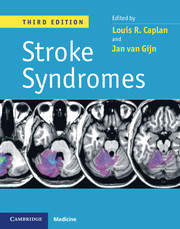Book contents
- Stroke Syndromes
- Stroke Syndromes
- Copyright page
- Contents
- Contributors
- Section 1 Clinical manifestations
- Chapter 1 Hemiparesis and other types of motor weakness
- Chapter 2 Sensory abnormalites
- Chapter 3 Cerebellar ataxia
- Chapter 4 Cognitive and behavioral manifestations of cerebellar strokes: their relation to motor control and functional topography in the cerebellum
- Chapter 5 Headache in cerebrovascular disease
- Chapter 6 Eye movement abnormalities
- Chapter 7 Cerebral visual dysfunction
- Chapter 8 Visual symptoms (eye)
- Chapter 9 Vestibular syndromes and vertigo
- Chapter 10 Auditory disorders in stroke
- Chapter 11 Abnormal movements in stroke
- Chapter 12 Seizures and stroke
- Chapter 13 Sleep–wake disturbances in stroke
- Chapter 14 Coma and abnormal consciousness
- Chapter 15 Aphasia and stroke
- Chapter 16 Agitation and delirium
- Chapter 17 Frontal lobe syndromes
- Chapter 18 Memory loss
- Chapter 19 Neurobehavioral aspects of deep hemisphere stroke
- 20 Right hemisphere syndromes
- Chapter 21 Poststroke dementia
- Chapter 22 Mood disorders
- Chapter 23 Agnosias, apraxias, and callosal disconnection syndromes
- Chapter 24 Muscle and peripheral nerve manifestations of stroke
- Chapter 25 Cardiac and autonomic manifestations of stroke
- Chapter 26 Dysarthria
- Chapter 27 Dysphagia and aspiration
- Chapter 28 Respiratory dysfunction
- Section 2 Vascular topographic syndromes
- Index
- Plate Section (PDF Only)
Chapter 24 - Muscle and peripheral nerve manifestations of stroke
from Section 1 - Clinical manifestations
Published online by Cambridge University Press: 05 August 2012
- Stroke Syndromes
- Stroke Syndromes
- Copyright page
- Contents
- Contributors
- Section 1 Clinical manifestations
- Chapter 1 Hemiparesis and other types of motor weakness
- Chapter 2 Sensory abnormalites
- Chapter 3 Cerebellar ataxia
- Chapter 4 Cognitive and behavioral manifestations of cerebellar strokes: their relation to motor control and functional topography in the cerebellum
- Chapter 5 Headache in cerebrovascular disease
- Chapter 6 Eye movement abnormalities
- Chapter 7 Cerebral visual dysfunction
- Chapter 8 Visual symptoms (eye)
- Chapter 9 Vestibular syndromes and vertigo
- Chapter 10 Auditory disorders in stroke
- Chapter 11 Abnormal movements in stroke
- Chapter 12 Seizures and stroke
- Chapter 13 Sleep–wake disturbances in stroke
- Chapter 14 Coma and abnormal consciousness
- Chapter 15 Aphasia and stroke
- Chapter 16 Agitation and delirium
- Chapter 17 Frontal lobe syndromes
- Chapter 18 Memory loss
- Chapter 19 Neurobehavioral aspects of deep hemisphere stroke
- 20 Right hemisphere syndromes
- Chapter 21 Poststroke dementia
- Chapter 22 Mood disorders
- Chapter 23 Agnosias, apraxias, and callosal disconnection syndromes
- Chapter 24 Muscle and peripheral nerve manifestations of stroke
- Chapter 25 Cardiac and autonomic manifestations of stroke
- Chapter 26 Dysarthria
- Chapter 27 Dysphagia and aspiration
- Chapter 28 Respiratory dysfunction
- Section 2 Vascular topographic syndromes
- Index
- Plate Section (PDF Only)
Summary
Keywords
- Type
- Chapter
- Information
- Stroke Syndromes, 3ed , pp. 287 - 293Publisher: Cambridge University PressPrint publication year: 2012

